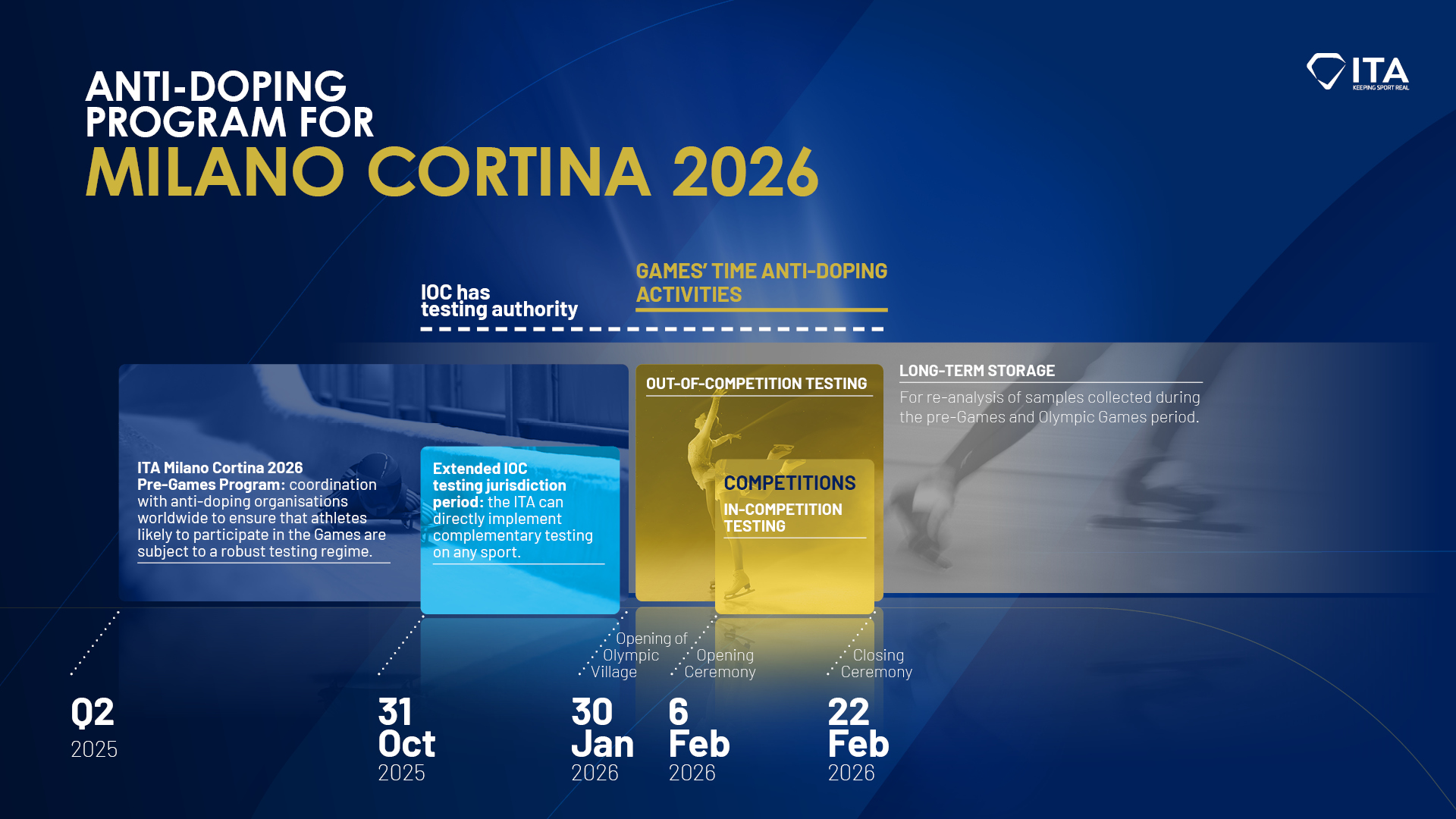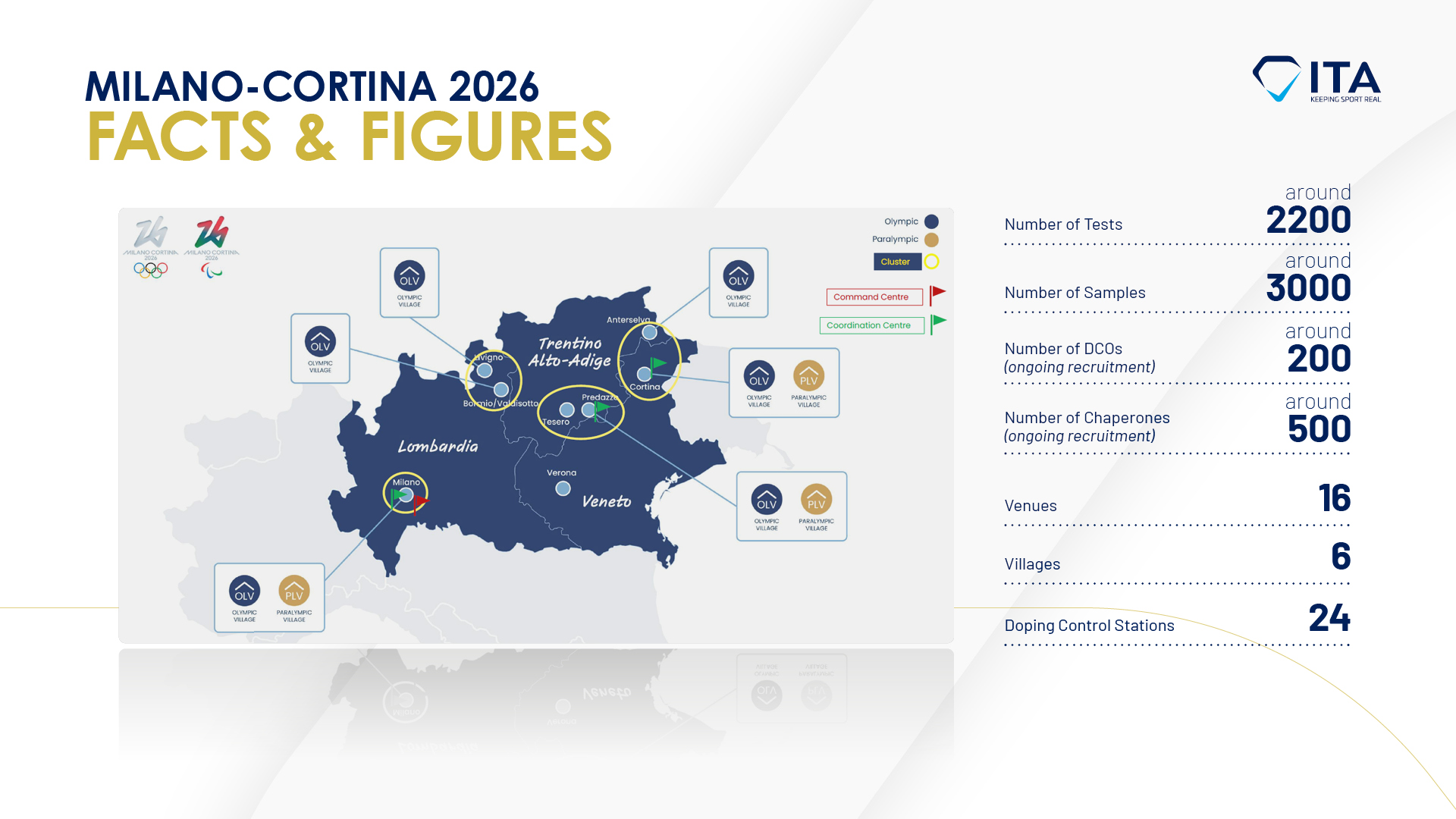Menu
The International Testing Agency (ITA) is leading an independent anti-doping program for the Olympic Winter Games Milano Cortina 2026 on behalf of the International Olympic Committee (IOC). To facilitate any questions that you as a journalist might have regarding the clean sport efforts we are leading for the Games, we have created the FAQ below to provide you with high-level information regarding the anti-doping program for Milano Cortina 2026.
We kindly ask you to first consult the FAQ before contacting us directly, you will find the ITA media contact at the bottom of this page.
Subscribe to our distribution list and receive ITA announcements in your mailbox – register here.
Subscribe to the ITA’s WhatsApp channel and receive our news during the Olympic Winter Games Milano Cortina 2026 directly on your phone.
On-site only for accredited journalists:
to be announced in December 2025
The ITA is an international organisation constituted as a not-for-profit foundation, based in Lausanne, Switzerland. Its mission is to manage anti-doping programs, independent from sporting or political powers and any real or perceived conflicts of interest, for International Federations (IFs), Major Event Organisers (MEOs) and all other anti-doping organisations requesting support.
We are a fair, transparent and intelligence-led organisation that has the welfare of athletes, the integrity of events and the reputation of sporting bodies at its heart. We gather together subject experts with significant experience in the field to help support the best sporting experience in compliance with the World Anti-Doping Code and its connected International Standards.
The ITA began its operations in July 2018 as the result of a desire for a united approach to keeping sport clean.
In accordance with the International Olympic Committee (IOC)’s anti-doping regulations applicable for the Olympic Winter Games Milano Cortina 2026, the IOC has handed over its entire anti-doping program to the ITA for it to be managed independently by dedicated experts who carry their know-how from one edition of the Games to another. The ITA is not only responsible for handling the pre-Games and Games-time anti-doping programs for all editions of the Olympic Games, but also leads re-analysis and long-term storage projects for the IOC.
The ITA has already implemented the anti-doping programs for the Olympic Games Tokyo 2020 and Paris 2024, for the Olympic Winter Games PyeongChang 2018 and Beijing 2022, and for all editions of the Summer and Winter Youth Olympic Games since the beginning of its operations.


For Beijing 2022, the ITA has led the most extensive anti-doping program ever implemented for an edition of the Olympic Winter Games. The same comprehensive, intelligence-led approach will be applied to the anti-doping program for Milano Cortina.
It is divided into the following stages:
Pre-Games
The ITA Milano Cortina 2026 Pre-Games Program supports worldwide anti-doping efforts ahead of the Games to ensure that athletes likely to participate in the event are subject to a robust and risk-proportionate testing regime.
Games-time anti-doping activities

The ITA will continue its intelligence-led pre-Games work on-site in Italy based on a multi-factor risk assessment, implementing out- and in-competition testing throughout the event, and plans on collecting approximately 3’000 samples. The ultimate number of collected samples will be determined by various factors on the ground, including any intelligence and information received. All doping controls are targeted and unannounced.
Long-term storage and re-analysis
All samples collected during Games-time will be stored for up to ten years and can be re-analysed if indicated or through the systematic re-analysis programs that have been implemented for all editions of the Olympic Games.
The foundations of the testing program for Milano Cortina 2026 are based upon a physiological/pharmacological risk assessment carried out by the ITA across all sports/disciplines. The risk assessment also takes into account data such as participating countries, risks and history of doping in these countries, testing statistics in these countries as well as intelligence received, and other factors. This risk assessment is a very fine-tuned instrument that the ITA has developed and serves as an indicator to target high-risk sports and countries.
The ITA plans on collecting approximately 3’000 urine, blood and dried-blood-spot samples during the Games-time period.
The samples collected during the Olympic Winter Games Milano Cortina 2026 will be analysed for substances as defined by the World Anti-Doping Agency’s Prohibited List.
Samples collected during the Games can be analysed for genetic doping if the physiological/pharmacological risk assessment or other information received indicates such an analysis.
24 doping control stations will be put in place at the various venues of the Olympic Winter Games Milano Cortina 2026.
The WADA-accredited anti-doping laboratory in Rome Laboratorio Antidoping FMSI will analyse all the samples collected by the ITA in Italy. The laboratory is an entity independent of the ITA. It is accredited by the World Anti-Doping Agency and under its monitoring. The Laboratorio Antidoping FMSI adheres to the highest standards and protocols as set forth in the International Standard for Laboratories.
The samples collected by the ITA and its implementing partners during the Olympic Winter Games Milano Cortina 2026 will be stored in a dedicated long-term storage (LTS) facility. Over the past decade, LTS of samples has emerged as one of the most impactful strategies to protect clean athletes and deter doping. Today, under the World Anti-Doping Code, samples can be stored for up to 10 years after their initial analysis and still retain the same legal impact if re-tested and prosecuted. This allows them to be re-analysed for previously undetected substances, should scientific breakthroughs enable new technologies and analysis methods.
Altogether, around 800 persons will be involved in delivering the Games-time anti-doping program for Milano Cortina 2026:
The doping control personnel and volunteers acting as chaperones are under the responsibility of the Organising Committee for Milano Cortina 2026, with whom the ITA works closely regarding the implementation of the ITA-led anti-doping program.
The ITA (on behalf of the IOC) is responsible for the results management and subsequent prosecution of Anti-Doping Rule Violations (ADRV) committed by any athlete, athlete support personnel or other person entered to participate in the Olympic Winter Games Milano Cortina 2026, under the jurisdiction of the IOC and as per the IOC Anti-Doping Rules.
Accordingly, any ADRV (eg. presence/ use of a prohibited substance tampering, refusing sample collection etc.) will be duly processed by the ITA and brought before the Anti-Doping Division of the Court of Arbitration for Sport (CAS ADD) as applicable.
The ITA will publish all anti-doping rule violations following the decision and publication by CAS ADD on this website (link will follow soon).
The ITA plans and implements the anti-doping program for Milano Cortina 2026 in strict compliance with the World Anti-Doping Code, its connected International Standards and the IOC’s anti-doping rules for Milano Cortina 2026.
Furthermore, the ITA collaborates closely with WADA’s Independent Observer team before and during the Games to ensure that any corrective actions they might suggest are implemented swiftly to the benefit of the full compliance and quality of the anti-doping program for Milano Cortina 2026.